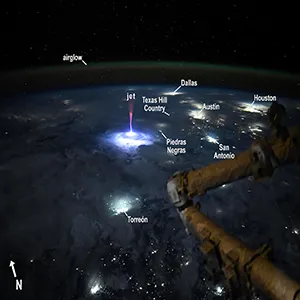NASA shares photos of an extraordinary event witnessed by astronauts on the space station
While most people witness only the familiar crack of thunder and flash of lightning from storms on Earth, brilliantly-colorful electric fireworks detonate much higher, in the thin air up to 55 miles overhead, easily seen from the ISS.
These brief spectacles – blue jets, red sprites, violet halos, ultraviolet rings – are collectively known as transient luminous events, or TLEs.
For decades, they eluded systematic study, appearing only in pilots’ anecdotes and the occasional lucky photograph.
The International Space Station (ISS) has changed that by offering an unobstructed seat above the storms, where specialized cameras and sensors capture every fleeting spark.
Piece by piece, researchers are discovering that what happens in this hidden layer can rattle radio transmissions, affect aircraft safety, and even tweak the chemistry of the upper atmosphere.
Storm laboratory bolted to the ISS
The centerpiece of this sky-watching mission is the Atmosphere–Space Interactions Monitor. ASIM, built by the European Space Agency, has clung to an external ISS platform since 2018.
Its job: watch Earth and record flashes smaller than a fingernail and shorter than a heartbeat.
The monitor’s high-speed cameras and photometers have already delivered more than scientists hoped.
Data show that certain lightning-like discharges at the crest of a thundercloud can pump electromagnetic energy into the ionosphere and ignite an enormous ring of ultraviolet light called an ELVES.
These rings can boost ionospheric charge for hundreds of miles, potentially disrupting long-distance radio signals.
ASIM has also catalogued ultra-brief corona discharges – bursts so short that ground-based instruments often miss them.
By timing and analyzing these coronas, researchers are beginning to understand how a cloud’s upper regions prime the pump for full-blown lightning.
Strange “red sprites” phenomenon
A mysterious phenomenon known as “red sprites” randomly occur in the mesosphere, hanging like upside-down jellyfish for a scant ten milliseconds. Blue jets spear from cloud tops toward the stratosphere with eerie, silent urgency.
Both events happen so fast and high that capturing their details was nearly impossible. Yet ASIM can spot them from orbit.
One study used its footage and ground instruments to pinpoint the altitude of a single blue jet. This confirmed that these upward bolts really do punch beyond the weather layer we know.
Those measurements feed directly into storm-charging models, which in turn inform aviation guidelines about where dangerous electrical fields might lurk.

ISS crew films storms from orbit
The ISS cupola – the seven-window observation dome often featured in astronaut selfies – has become part of the scientific toolkit.
Through ESA’s Thor-Davis experiment, ISS crewmembers attach a state-of-the-art camera behind the glass and capture distant storms at up to one hundred thousand frames per second.
The resulting slow-motion movies reveal electrical filaments proliferating in ways textbooks never predicted.
By capturing lightning’s split-second branching in vivid detail, Thor-Davis helps scientists validate laboratory plasma tests against real-world events.
More practically, the footage might one day improve the algorithms that warn power-grid operators when severe lightning threatens transmission lines.
Catching invisible lightning pulses
Lightning’s hidden drama is not limited to visible colors. Some strikes trigger terrestrial gamma-ray flashes, pulses of radiation energetic enough to dowse an airliner in a brief surge equivalent to a chest X-ray.
To map these invisible hazards, the Japan Aerospace Exploration Agency worked with university partners to release Light-1 from the ISS.
Though no larger than a loaf of bread, the CubeSat carries detectors fine-tuned to high-energy photons.
As Light-1 records flashes over equatorial storm systems, researchers plan to line up its timestamps with global lightning networks on the ground.
Over time, this will help build a three-dimensional atlas of where gamma-ray flashes fire most often.

Storms mess with signals
At first glance, a sprite or ELVES ring might seem like nothing more than meteorological curiosity – a sky-high cousin of the aurora.
Yet these flashes erupt in the same charged layers that carry radio waves and relay signals to submarines. Disturb those layers and communications can fade or fail without warning.
For airlines, understanding when and where blue jets or gamma-ray flashes appear adds another layer of safety planning on polar or equatorial routes.
Scientists also care about climate. TLEs and corona discharges shuffle nitrogen oxides and other chemicals between atmospheric strata, altering ozone chemistry and radiative balance.
Incorporating this vertical mixing into climate models can tighten predictions of future warming.
Lightning trackers get upgrades
With the ISS likely to operate through the decade, ASIM and its successors will continue collecting a library of once-invisible storm events.
Engineers envision next-gen detectors that trigger automatically, record faster, and span a broader spectrum- from radio to hard X-ray.
CubeSats like Light-1 could multiply into a fleet, feeding real-time alerts to weather agencies and satellite operators whenever a gamma flash or mega-sprite erupts.
Above all, the space station shows that to grasp Earth’s weather, one must sometimes look down from above. Each orbit adds a few more frames to lightning’s hidden movie reel.
Those frames bring us closer to predicting – and perhaps mitigating – the electrical surprises that storms fling toward the edge of space.
—–
Like what you read? Subscribe to our newsletter for engaging articles, exclusive content, and the latest updates.
Check us out on EarthSnap, a free app brought to you by Eric Ralls and Earth.com.
—–













